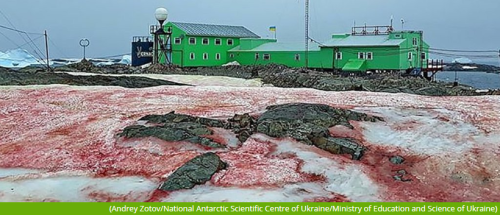A few weeks ago, scientists at Ukraine's Vernadsky Research base in Antarctica awoke to find their usually pristine white surrounds drenched in a shocking blood-red.
几周前,位于南极的乌克兰沃纳德斯基研究站的科学家醒来发现周围原本白茫茫的雪地被染成了血红色,令人震惊。
From the gory-looking images, you could be forgiven for wondering if there'd been some sort of horror-movie-style penguin massacre. The good news is that the real cause is far less dramatic; unfortunately, it still has dire implications.
看着这些“血淋淋”的照片,难怪你会好奇这里是不是出现了恐怖电影里的企鹅大屠杀。好消息是真实的原因并没有那么可怕;坏消息是这种情况会有可怕的影响。

Marine ecologist Andrey Zotov from the National Academy of Sciences of Ukraine, captured these images while conducting research at the Antarctic station. For such an epic mess, the culprits behind this dramatic redecoration are incredibly tiny.
乌克兰国家科学院的海洋生态学家Andrey Zotov在南极站进行研究时拍下了这些照片。这场景史无前例,但这种戏剧性变化背后的罪魁祸首却极其微小。
"Our scientists have identified them under a microscope as Chlamydomonas nivalis," said the National Antarctic Scientific Centre of Ukraine in a Facebook post.
乌克兰国家南极科学中心在Facebook上发的一篇文章中说:“我们的科学家通过在显微镜下观察,已经确定了它们是雪地衣藻。”
These microscopic green algae (we'll get to why they look red in a moment), a type of single-cellular seaweed, are common in all icy and snowy regions of Earth, from the arctic to alpine regions.
这些微生绿藻(我们一会就知道它们为什么是红色的了)是一种单细胞海藻,在地球上被冰雪覆盖的地区很常见,从北极到高山地区都有。
They lie slumbering during the brutal winter, but once the sunlight warms enough to soften their crystallised world, the algae spring awake, making use of the meltwater and sunlight to rapidly bloom.
寒冬时期它们会冬眠,一旦阳光变暖,冰雪融化,藻类就苏醒了,利用融水和阳光迅速开花。
"The algae need liquid water in order to bloom," University of Leeds microbiologist Steffi Lutz told Gizmodo in 2016.
利兹大学微生物学家Steffi Lutz在2016年告诉Gizmodo(美国一个知名科技博客):“这种藻类需要液态水来开花。”
"[The algal blooms] contribute to climate change," the centre stated.
该中心表示:“‘藻花’会加速气候变化。”
A study in 2016 showed that snow algal blooms can decrease the amount of light reflected from the snow (also know as albedo) by up to 13 percent across one melt season in the Arctic.
2016年的一项研究表明,雪藻花会减少雪对光的反射(也叫反照率),北极一个融冰季节会减少13%。
"This will invariably result in higher melt rates," the researchers wrote.
研究人员写道:“这必然会导致融化加速。”
In 2017 environmental scientists calculated that microbial communities, which include C. nivalis, contributed to over a sixth of the snowmelt where they were present in Alaskan icefields. Their experiments showed that areas with more meltwater led to the growth of 50 percent more algae and places with more algae melted further.
环境科学家在2017年计算过,在雪地衣藻出现的阿拉斯加冰原上超过六分之一的融雪都是由包括雪地衣藻在内的微生物群落造成的。他们的实验表明融水更多的地区藻类会增加50%,而藻类更多的地区还会进一步融化。
This Antarctic summer has certainly seen a lot more meltwater than usual. Temperature records keep tumbling, leading to rapid melting at a scale previously only seen in the Northern Hemisphere.
今年夏天,南极的融水比往年要多得多,温度纪录不断刷新,如此大规模快速融化以前只在北半球出现过。